1T-ZrS2 Monolayer Decorated with Sc, Ti, and V Single Atoms: A Potential Gas Scavenger for NOx and SO2
Abstract
1. Introduction
2. Computational Details
3. Results and Discussion
3.1. Geometry and Electronic Structure of the 1T-ZrS2 Monolayer Decorated with Sc, Ti, and V Single Atoms
3.2. Adsorption of NO on TM-Decorated 1T-ZrS2 Monolayers
3.3. Adsorption of NO2 on TM-Decorated 1T-ZrS2 Monolayers
3.4. Adsorption of SO2 on TM-Decorated 1T-ZrS2 Monolayers
3.5. Gas Sensing Properties of TM-Decorated 1T-ZrS2 Monolayers
4. Conclusions
Supplementary Materials
Author Contributions
Funding
Data Availability Statement
Conflicts of Interest
References
- Jion, M.M.F.; Jannat, J.N.; Mia, M.Y.; Ali, M.A.; Islam, M.S.; Ibrahim, S.M.; Pal, S.C.; Islam, A.; Sarker, A.; Malafaia, G.; et al. A Critical Review and Prospect of NO2 and SO2 Pollution over Asia: Hotspots, Trends, and Sources. Sci. Total Environ. 2023, 876, 162851. [Google Scholar] [CrossRef]
- Lewis, A.; Edwards, P. Validate Personal Air-Pollution Sensors. Nature 2016, 535, 29–31. [Google Scholar] [CrossRef]
- Yang, J.; Sun, R.; Bao, X.; Liu, J.; Ng, J.W.; Tang, B.; Liu, Z. Enhancing Selectivity of Two-Dimensional Materials-Based Gas Sensors. Adv. Funct. Mater. 2025, 35, 2420393. [Google Scholar] [CrossRef]
- Feng, Q.; Huang, B.; Li, X. Graphene-Based Heterostructure Composite Sensing Materials for Detection of Nitrogen-Containing Harmful Gases. Adv. Funct. Mater. 2021, 31, 2104058. [Google Scholar] [CrossRef]
- Tyagi, D.; Wang, H.; Huang, W.; Hu, L.; Tang, Y.; Guo, Z.; Ouyang, Z.; Zhang, H. Recent Advances in Two-Dimensional-Material-Based Sensing Technology toward Health and Environmental Monitoring Applications. Nanoscale 2020, 12, 3535–3559. [Google Scholar] [CrossRef] [PubMed]
- Cui, H.; Zhang, G.; Zhang, X.; Tang, J. Rh-Doped MoSe2 as a Toxic Gas Scavenger: A First-Principles Study. Nanoscale Adv. 2019, 1, 772–780. [Google Scholar] [CrossRef] [PubMed]
- Luo, L.; Guo, Y.; Zhu, T.; Zheng, Y. Adsorption Species Distribution and Multicomponent Adsorption Mechanism of SO2, NO, and CO2 on Commercial Adsorbents. Energy Fuels 2017, 31, 11026–11033. [Google Scholar] [CrossRef]
- Zheng, R.; Qiu, L.; Zhou, X.; Liu, X.; Wang, Q.; Wang, C.; Zhu, T.; Chang, H. Research Progress in CO2 and NOx Adsorption by Two-Dimensional Materials. Catal. Sci. Technol. 2025, 15, 5950–5973. [Google Scholar] [CrossRef]
- Joshi, M.; Ren, X.; Lin, T.; Joshi, R. Mechanistic Insights into Gas Adsorption on 2D Materials. Small 2025, 21, 2406706. [Google Scholar] [CrossRef]
- Liu, X.; Zhang, Y.; Wang, C.; Shen, L. Polar Materials for Photocatalytic Applications: A Critical Review. Interdiscip. Mater. 2024, 3, 530–564. [Google Scholar] [CrossRef]
- Pawar, K.K.; Kumar, A.; Mirzaei, A.; Kumar, M.; Kim, H.W.; Kim, S.S. 2D Nanomaterials for Realization of Flexible and Wearable Gas Sensors: A Review. Chemosphere 2024, 352, 141234. [Google Scholar] [CrossRef] [PubMed]
- Wu, P.; Li, Y.; Yang, A.; Tan, X.; Chu, J.; Zhang, Y.; Yan, Y.; Tang, J.; Yuan, H.; Zhang, X.; et al. Advances in 2D Materials Based Gas Sensors for Industrial Machine Olfactory Applications. ACS Sens. 2024, 9, 2728–2776. [Google Scholar] [CrossRef] [PubMed]
- Tian, X.; Wang, S.; Li, H.; Li, M.; Chen, T.; Xiao, X.; Wang, Y. Recent Advances in MoS2-Based Nanomaterial Sensors for Room-Temperature Gas Detection: A Review. Sens. Diagn. 2023, 2, 361–381. [Google Scholar] [CrossRef]
- Hou, W.; Mi, H.; Peng, R.; Peng, S.; Zeng, W.; Zhou, Q. First-Principle Insight into Ga-Doped MoS2 for Sensing SO2, SOF2 and SO2F2. Nanomaterials 2021, 11, 314. [Google Scholar] [CrossRef]
- Kumar, S.; Meng, G.; Mishra, P.; Tripathi, N.; Bannov, A.G. A Systematic Review on 2D MoS2 for Nitrogen Dioxide (NO2) Sensing at Room Temperature. Mater. Today Commun. 2023, 34, 105045. [Google Scholar] [CrossRef]
- Agrawal, A.V.; Kumar, N.; Kumar, M. Strategy and Future Prospects to Develop Room-Temperature-Recoverable NO2 Gas Sensor Based on Two-Dimensional Molybdenum Disulfide. Nano Micro Lett. 2021, 13, 38. [Google Scholar] [CrossRef]
- Zheng, W.; Xu, Y.; Zheng, L.; Yang, C.; Pinna, N.; Liu, X.; Zhang, J. MoS2 van Der Waals p-n Junctions Enabling Highly Selective Room-Temperature NO2 Sensor. Adv. Funct. Mater. 2020, 30, 2000435. [Google Scholar] [CrossRef]
- Kumar, R.; Zheng, W.; Liu, X.; Zhang, J.; Kumar, M. MoS2-Based Nanomaterials for Room-Temperature Gas Sensors. Adv. Mater. Technol. 2020, 5, 1901062. [Google Scholar] [CrossRef]
- Pham, T.; Li, G.; Bekyarova, E.; Itkis, M.E.; Mulchandani, A. MoS2-Based Optoelectronic Gas Sensor with Sub-Parts-per-Billion Limit of NO2 Gas Detection. ACS Nano 2019, 13, 3196–3205. [Google Scholar] [CrossRef]
- Lau, T.H.M.; Lu, X.; Kulhavý, J.; Wu, S.; Lu, L.; Wu, T.-S.; Kato, R.; Foord, J.S.; Soo, Y.-L.; Suenaga, K.; et al. Transition Metal Atom Doping of the Basal Plane of MoS2 Monolayer Nanosheets for Electrochemical Hydrogen Evolution. Chem. Sci. 2018, 9, 4769–4776. [Google Scholar] [CrossRef]
- Kumar, R.; Goel, N.; Kumar, M. High Performance NO2 Sensor Using MoS2 Nanowires Network. Appl. Phys. Lett. 2018, 112, 53502. [Google Scholar] [CrossRef]
- Ma, Y.; Zhang, D.; Ding, Z.; Ma, K. Strain-Tunable Gas Sensing Properties of Ag- and Au-Doped SnSe2 Monolayers for the Detection of NO, NO2, SO2, H2S and HCN. Nanomaterials 2025, 15, 1454. [Google Scholar] [CrossRef] [PubMed]
- Cho, B.; Hahm, M.G.; Choi, M.; Yoon, J.; Kim, A.R.; Lee, Y.-J.; Park, S.-G.; Kwon, J.-D.; Kim, C.S.; Song, M.; et al. Charge-Transfer-Based Gas Sensing Using Atomic-Layer MoS2. Sci. Rep. 2015, 5, 8052. [Google Scholar] [CrossRef] [PubMed]
- Scardamaglia, M.; Casanova-Cháfer, J.; Temperton, R.; Annanouch, F.E.; Mohammadpour, A.; Malandra, G.; Das, A.; Alagh, A.; Arbouch, I.; Montoisy, L.; et al. Operando Investigation of WS2 Gas Sensors: Simultaneous Ambient Pressure X-ray Photoelectron Spectroscopy and Electrical Characterization in Unveiling Sensing Mechanisms during Toxic Gas Exposure. ACS Sens. 2024, 9, 4079–4088. [Google Scholar] [CrossRef]
- Zhang, M.; Zhu, Y.; Wang, X.; Feng, Q.; Qiao, S.; Wen, W.; Chen, Y.; Cui, M.; Zhang, J.; Cai, C.; et al. Controlled Synthesis of ZrS2 Monolayer and Few Layers on Hexagonal Boron Nitride. J. Am. Chem. Soc. 2015, 137, 7051–7054. [Google Scholar] [CrossRef]
- Zeng, Z.; Yin, Z.; Huang, X.; Li, H.; He, Q.; Lu, G.; Boey, F.; Zhang, H. High-Yield Preparation of Single- and Few-Layer Transition Metal Dichalcogenides by Electrochemical Lithium Intercalation and Exfoliation. Angew. Chem. Int. Ed. 2011, 50, 11093–11097. [Google Scholar] [CrossRef]
- Tian, Y.; Li, W.; Zhou, J.; Chen, X.; Zhang, H.; Xie, L.; Li, S.; Wang, C. Epitaxial Growth of Large-Area ZrS2 Thin Films on Sapphire for High-Performance Photodetectors. Nano Res. 2022, 15, 5678–5686. [Google Scholar] [CrossRef]
- Turcicova, H.; Novak, O.; Muzik, J.; Stepankova, D.; Smrz, M.; Mocek, T. Laser Induced Damage Threshold (LIDT) of β-Barium Borate (BBO) and Cesium Lithium Borate (CLBO)—Overview. Opt. Laser Technol. 2022, 149, 107876. [Google Scholar] [CrossRef]
- Ma, J.; Li, S.; Huang, X.; Jiang, J.; Xu, T.; Liu, T. All Optic-Fiber Waveguide-Coupled SPR Sensor for CRP Sensing Based on Dielectric Layer and Poly-Dopamine. Photonic Sens. 2025, 15, 250224. [Google Scholar] [CrossRef]
- Wang, N.; Zhang, G.; Wang, G.; Feng, Z.; Li, Q.; Zhang, H.; Li, Y.; Liu, C. Pressure-induced Enhancement and Retainability of Optoelectronic Properties in Layered Zirconium Disulfide. Small 2024, 20, 2400216. [Google Scholar] [CrossRef]
- Li, L.; Lv, R.; Wang, J.; Chen, Z.; Wang, H.; Liu, S.; Ren, W.; Liu, W.; Wang, Y. Optical Nonlinearity of ZrS2 and Applications in Fiber Laser. Nanomaterials 2019, 9, 315. [Google Scholar] [CrossRef] [PubMed]
- Lei, G.; Pan, H.; Mei, H.; Liu, X.; Lu, G.; Lou, C.; Li, Z.; Zhang, J. Emerging Single Atom Catalysts in Gas Sensors. Chem. Soc. Rev. 2022, 51, 7260–7280. [Google Scholar] [CrossRef] [PubMed]
- Chu, T.; Rong, C.; Zhou, L.; Mao, X.; Zhang, B.; Xuan, F. Progress and Perspectives of Single-Atom Catalysts for Gas Sensing. Adv. Mater. 2023, 35, 2206783. [Google Scholar] [CrossRef] [PubMed]
- Wang, X.; Zhang, Y.; Wu, J.; Zhang, Z.; Liao, Q.; Kang, Z.; Zhang, Y. Single-Atom Engineering to Ignite 2D Transition Metal Dichalcogenide Based Catalysis: Fundamentals, Progress, and Beyond. Chem. Rev. 2022, 122, 1273–1348. [Google Scholar] [CrossRef]
- Yong, Y.; Gao, R.; Yuan, X.; Zhao, Z.; Hu, S.; Kuang, Y. Gas Sensing and Capturing Based on the C7N6 Monolayer with and without Metal Decoration: A First-Principles Investigation. Appl. Surf. Sci. 2022, 591, 153129. [Google Scholar] [CrossRef]
- Liu, K.; Lin, L.; Wang, Y. Adsorption and Sensing Properties of ZrSe2 Monolayer Decorated with Transition Metal for CO2, NO2 and SO2 Gases: First-Principles Calculations. Mater. Today Commun. 2023, 36, 106698. [Google Scholar] [CrossRef]
- Zhang, B.; Liu, K.; Xie, K.; Wang, P.; Lin, L.; Su, L. Adsorption of Toxic and Harmful Gas NO2 and SO2 on TM (Fe, Co and Ni) Decorated ZrSe2 Monolayer: A DFT Study. Mater. Today Commun. 2024, 39, 108483. [Google Scholar] [CrossRef]
- Wu, Y.-Y.; Li, W.; Ren, Q.-Y.; Li, J.-Z.; Xu, W.; Xu, J. First-Principles Study on Adsorption of Gas Molecules by Metal Sc Modified Ti2CO2. Acta Phys. Sin. 2024, 73, 73101. [Google Scholar] [CrossRef]
- Zhang, J.; Zhu, X.; Zhu, K.; Shen, J.; Xu, Y.; Chen, D.; Wang, P. Adsorption of NO2 and NH3 on Single-Atom (Co, Pd, Pt)-Decorated 2H-MoS2 Monolayer: A DFT Study. Results Phys. 2023, 51, 106694. [Google Scholar] [CrossRef]
- Liu, Y.; Liu, J.; Wei, Z.; Yuan, T.; Cui, H. Single Ni Atom-Dispersed WSe2 Monolayer for Sensing Typical Fault Gases in Dry-Type Transformers: A First-Principles Study. ACS Omega 2023, 8, 47067–47074. [Google Scholar] [CrossRef]
- Liu, K.; Lin, L.; Xie, K.; Shi, P.; Xu, D. Adsorption and Gas-Sensing Performance of the Small-Molecule Gas on ZrSe2 Monolayers: A First-Principles Study. Langmuir 2023, 39, 8879–8888. [Google Scholar] [CrossRef] [PubMed]
- Wang, Z.; Wang, D.; Xie, K.; Shi, P.; Shen, Y.; Lin, L. Theoretical Calculation of Dissolved Gas in Transformer Oil Using the Gas Sensitive Properties of Sc- and Ti-Modified ZrS2. Langmuir 2024, 40, 24576–24584. [Google Scholar] [CrossRef] [PubMed]
- Tan, S.; Bi, M.; Lei, S.; He, X.; Hu, X.; He, J.; Jiang, T. Adsorption of SF6 Decomposition Gases (H2S, SO2 and SOF2) on TM (Pd and Pt) Modified Monolayer ZrS2: A DFT Study. Comput. Theor. Chem. 2024, 1236, 114586. [Google Scholar] [CrossRef]
- Lin, X.-Q.; Zhang, X.; Qin, Y.-Y.; Yao, Y.-G. Tuning the Gas Sensing Properties of ZrS2 Monolayers via Pt Decoration: Insights from DFT Simulations. Langmuir 2025, 41, 6801–6815. [Google Scholar] [CrossRef]
- Guang, Q.; Huang, B.; Li, X. Au-Decorated WS2 Microflakes Based Sensors for Selective Ammonia Detection at Room Temperature. Chemosensors 2022, 10, 9. [Google Scholar] [CrossRef]
- Park, J.; Mun, J.; Shin, J.-S.; Kang, S.-W. Highly Sensitive Two-Dimensional MoS2 Gas Sensor Decorated with Pt Nanoparticles. R. Soc. Open Sci. 2018, 5, 181462. [Google Scholar] [CrossRef]
- Zhang, L.; Huang, Z.; Xia, S. Sc-Doped Sulfur Vacancy MoS2 Photocatalytic Nitrogen Reduction to Ammonia: Experimental and Theoretical Investigation. Inorg. Chem. 2025, 64, 15736–15747. [Google Scholar] [CrossRef]
- Ma, Z.; Ren, C.; Wu, Y.; Qiu, H.; Liu, H.; Hu, Z.; Wu, Y. Dopant-induced Giant Photoluminescence of Monolayer MoS2 by Chemical Vapor Transport. Adv. Mater. Interfaces 2022, 9, 2200431. [Google Scholar] [CrossRef]
- Sahoo, K.R.; Guha, A.; Bawari, S.; Sharma, R.; Maity, D.; Narayanan, T.N. Basal Plane Activation of MoS2 by the Substitutional Doping of Vanadium toward Electrocatalytic Hydrogen Generation. ACS Appl. Energy Mater. 2022, 5, 11263–11270. [Google Scholar] [CrossRef]
- Kohn, W.; Sham, L.J. Self-Consistent Equations Including Exchange and Correlation Effects. Phys. Rev. 1965, 140, A1133–A1138. [Google Scholar] [CrossRef]
- Kresse, G.; Furthmüller, J. Efficient Iterative Schemes for Ab Initio Total-Energy Calculations Using a Plane-Wave Basis Set. Phys. Rev. B 1996, 54, 11169–11186. [Google Scholar] [CrossRef]
- Kresse, G.; Furthmüller, J. Efficiency of Ab-Initio Total Energy Calculations for Metals and Semiconductors Using a Plane-Wave Basis Set. Comput. Mater. Sci. 1996, 6, 15–50. [Google Scholar] [CrossRef]
- Zhang, Y.; Pan, W.; Yang, W. Describing van Der Waals Interaction in Diatomic Molecules with Generalized Gradient Approximations: The Role of the Exchange Functional. J. Chem. Phys. 1997, 107, 7921–7925. [Google Scholar] [CrossRef]
- Kresse, G.; Joubert, D. From Ultrasoft Pseudopotentials to the Projector Augmented-Wave Method. Phys. Rev. B 1999, 59, 1758–1775. [Google Scholar] [CrossRef]
- Blöchl, P.E. Projector Augmented-Wave Method. Phys. Rev. B 1994, 50, 17953–17979. [Google Scholar] [CrossRef]
- Grimme, S.; Antony, J.; Ehrlich, S.; Krieg, H. A Consistent and Accurate Ab Initio Parametrization of Density Functional Dispersion Correction (DFT-D) for the 94 Elements H-Pu. J. Chem. Phys. 2010, 132, 154104. [Google Scholar] [CrossRef]
- Monkhorst, H.J.; Pack, J.D. Special Points for Brillouin-Zone Integrations. Phys. Rev. B 1976, 13, 5188–5192. [Google Scholar] [CrossRef]
- Lau, K.W.; Cocchi, C.; Draxl, C. Electronic and Optical Excitations of Two-Dimensional ZrS2 and HfS2 and Their Heterostructure. Phys. Rev. Mater. 2019, 3, 74001. [Google Scholar] [CrossRef]
- Li, Y.; Kang, J.; Li, J. Indirect-to-Direct Band Gap Transition of the ZrS2 Monolayer by Strain: First-Principles Calculations. RSC Adv. 2014, 4, 7396. [Google Scholar] [CrossRef]
- Wang, V.; Xu, N.; Liu, J.-C.; Tang, G.; Geng, W.-T. VASPKIT: A User-Friendly Interface Facilitating High-Throughput Computing and Analysis Using VASP Code. Comput. Phys. Commun. 2021, 267, 108033. [Google Scholar] [CrossRef]
- Momma, K.; Izumi, F. VESTA 3 for Three-Dimensional Visualization of Crystal, Volumetric and Morphology Data. J. Appl. Crystallogr. 2011, 44, 1272–1276. [Google Scholar] [CrossRef]
- Maintz, S.; Deringer, V.L.; Tchougréeff, A.L.; Dronskowski, R. LOBSTER: A Tool to Extract Chemical Bonding from Plane-wave Based DFT. J. Comput. Chem. 2016, 37, 1030–1035. [Google Scholar] [CrossRef]
- Dronskowski, R.; Bloechl, P.E. Crystal Orbital Hamilton Populations (COHP): Energy-Resolved Visualization of Chemical Bonding in Solids Based on Density-Functional Calculations. J. Phys. Chem. 1993, 97, 8617–8624. [Google Scholar] [CrossRef]
- Bader, R.F.W. Atoms in Molecules: A Quantum Theory; Clarendon Press: Oxford, UK, 1994. [Google Scholar]
- Tang, W.; Sanville, E.; Henkelman, G. A grid-based Bader analysis algorithm without lattice bias. J. Phys. Condens. Matter 2009, 21, 084204. [Google Scholar] [CrossRef] [PubMed]
- Sanville, E.; Kenny, S.D.; Smith, R.; Henkelman, G. An Improved Grid-Based Algorithm for Bader Charge Allocation. J. Comput. Chem. 2007, 28, 899–908. [Google Scholar] [CrossRef] [PubMed]
- Henkelman, G.; Arnaldsson, A.; Jónsson, H. A Fast and Robust Algorithm for Bader Decomposition of Charge Density. Comput. Mater. Sci. 2006, 36, 254–360. [Google Scholar] [CrossRef]
- Becke, A.D.; Edgecombe, K.E. A Simple Measure of Electron Localization in Atomic and Molecular Systems. J. Chem. Phys. 1990, 92, 5397–5403. [Google Scholar] [CrossRef]
- Silvi, B.; Savin, A. Classification of Chemical Bonds Based on Topological Analysis of Electron Localization Functions. Nature 1994, 371, 683–686. [Google Scholar] [CrossRef]
- Kühne, T.D.; Iannuzzi, M.; Del Ben, M.; Rybkin, V.V.; Seewald, P.; Stein, F.; Laino, T.; Khaliullin, R.Z.; Schütt, O.; Schiffmann, F.; et al. CP2K: An Electronic Structure and Molecular Dynamics Software Package—Quickstep: Efficient and Accurate Electronic Structure Calculations. J. Chem. Phys. 2020, 152, 194103. [Google Scholar] [CrossRef]
- Lu, T. A Comprehensive Electron Wavefunction Analysis Toolbox for Chemists, Multiwfn. J. Chem. Phys. 2024, 161, 82503. [Google Scholar] [CrossRef]
- Lu, T.; Chen, F. Multiwfn: A Multifunctional Wavefunction Analyzer. J. Comput. Chem. 2012, 33, 580–592. [Google Scholar] [CrossRef] [PubMed]
- Karbalaee Aghaee, A.; Belbasi, S.; Hadipour, H. Ab Initio Calculation of the Effective Coulomb Interactions in MX2 (M = Ti, V, Cr, Mn, Fe, Co, Ni; X = S, Se, Te): Intrinsic Magnetic Ordering and Mott Phase. Phys. Rev. B 2022, 105, 115115. [Google Scholar] [CrossRef]
- Hu, T.; Li, Z.; Hu, M.; Wang, J.; Hu, Q.; Li, Q.; Wang, X. Chemical Origin of Termination-Functionalized MXenes: Ti3C2T2 as a Case Study. J. Phys. Chem. C 2017, 121, 19254–19261. [Google Scholar] [CrossRef]
- Yi, W.; Tang, G.; Chen, X.; Yang, B.; Liu, X. Qvasp: A Flexible Toolkit for VASP Users in Materials Simulations. Comput. Phys. Commun. 2020, 257, 107535. [Google Scholar] [CrossRef]
- Han, Y. An Evaluation for Geometries, Formation Enthalpies, and Dissociation Energies of Diatomic and Triatomic (C, H, N, O), NO3, and HNO3 Molecules from the PAW DFT Method with PBE and optB88-vdW Functionals. AIP Adv. 2022, 12, 120501. [Google Scholar] [CrossRef]
- Zhu, M.-Q.; Wang, X.-F.; Vasilopoulos, P. Transition Metal-Doped ZrS2 Monolayer as Potential Gas Sensor for CO2, SO2, and NO2: Density Functional Theory and Non-Equilibrium Green’s Functions Analysis. J. Phys. D Appl. Phys. 2025, 58, 135306. [Google Scholar] [CrossRef]
- Xin, Q.; Zhao, X.; Ma, X.; Wu, N.; Liu, X.; Wei, S. Electronic Structure in 1T-ZrS2 Monolayer by Strain. Phys. E Low-Dimens. Syst. Nanostructures 2017, 93, 87–91. [Google Scholar] [CrossRef]
- Zhao, X.; Zhang, X.; Wang, T.; Wei, S.; Yang, L. Electronic Structures and Optical Properties of ZrS2 Monolayer by N- and P-Type Doping. J. Alloys Compd. 2018, 748, 798–803. [Google Scholar] [CrossRef]
- Raya, S.S.; Ansari, A.S.; Shong, B. Molecular Adsorption of NH3 and NO2 on Zr and Hf Dichalcogenides (S, Se, Te) Monolayers: A Density Functional Theory Study. Nanomaterials 2020, 10, 1215. [Google Scholar] [CrossRef]
- Chen, Y.; Gui, Y.; Chen, X. Adsorption and Gas-Sensing Properties of C2H4, CH4, H2, H2O on Metal Oxides (CuO, NiO) Modified SnS2 Monolayer: A DFT Study. Results Phys. 2021, 28, 104680. [Google Scholar] [CrossRef]
- Zhang, Y.-H.; Chen, Y.-B.; Zhou, K.-G.; Liu, C.-H.; Zeng, J.; Zhang, H.-L.; Peng, Y. Improving Gas Sensing Properties of Graphene by Introducing Dopants and Defects: A First-Principles Study. Nanotechnology 2009, 20, 185504. [Google Scholar] [CrossRef]
- Peng, S.; Cho, K.; Qi, P.; Dai, H. Ab Initio Study of CNT NO2 Gas Sensor. Chem. Phys. Lett. 2004, 387, 271–276. [Google Scholar] [CrossRef]
- Guo, C.; Wang, Z.; Wang, D.; Wang, H.-F.; Hu, P. First-Principles Determination of CO Adsorption and Desorption on Pt (111) in the Free Energy Landscape. J. Phys. Chem. C 2018, 122, 21478–21483. [Google Scholar] [CrossRef]
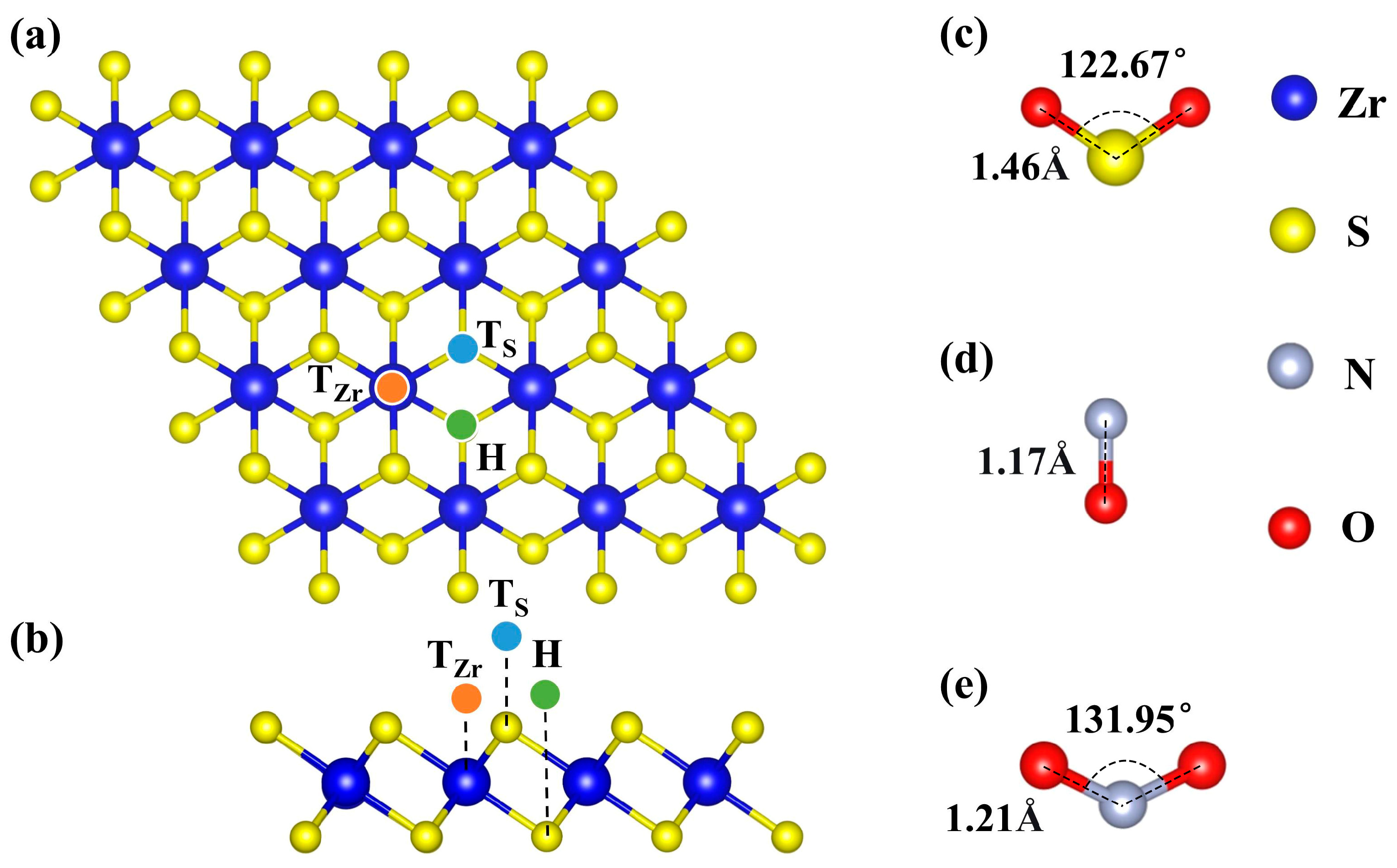
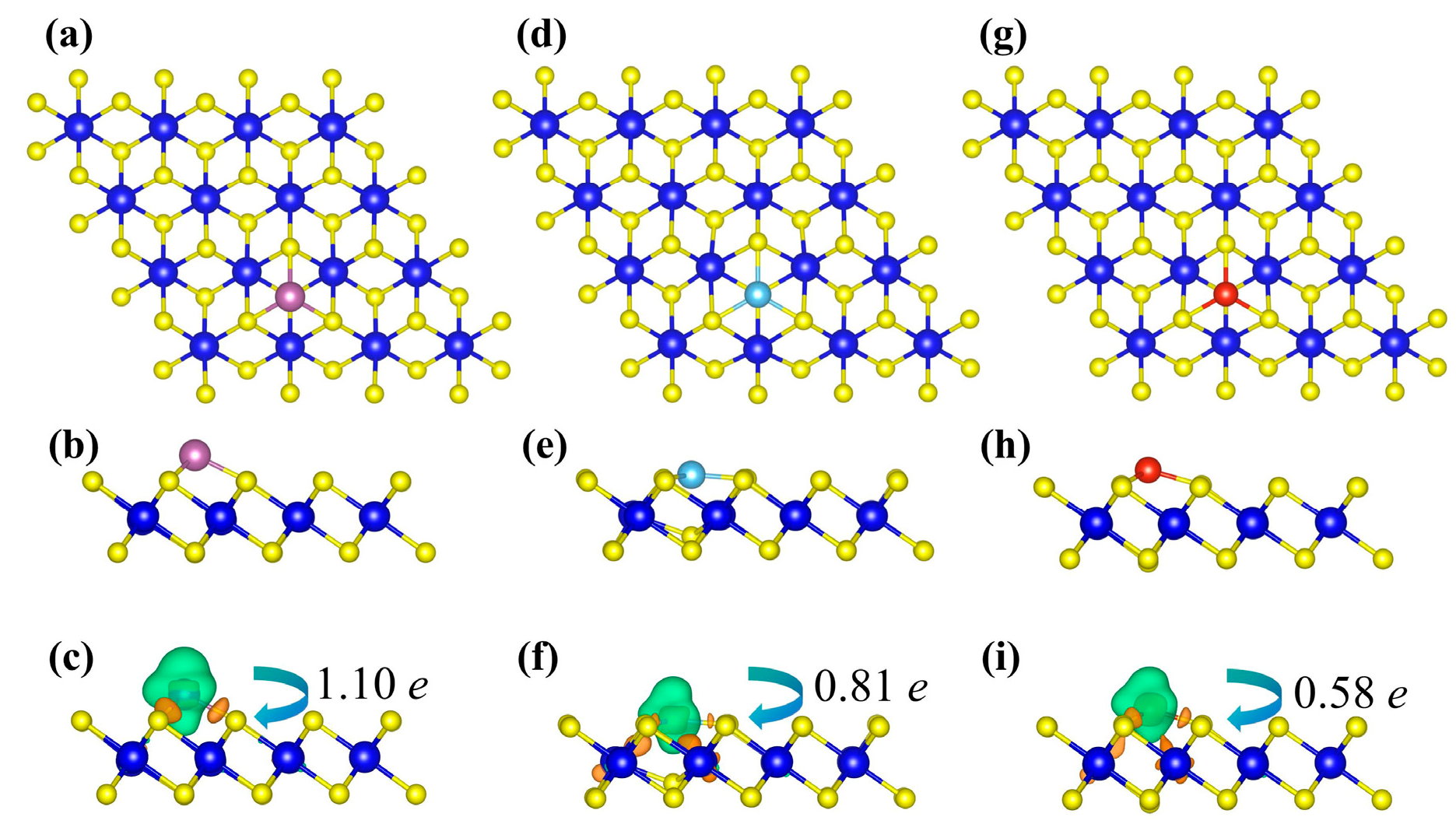
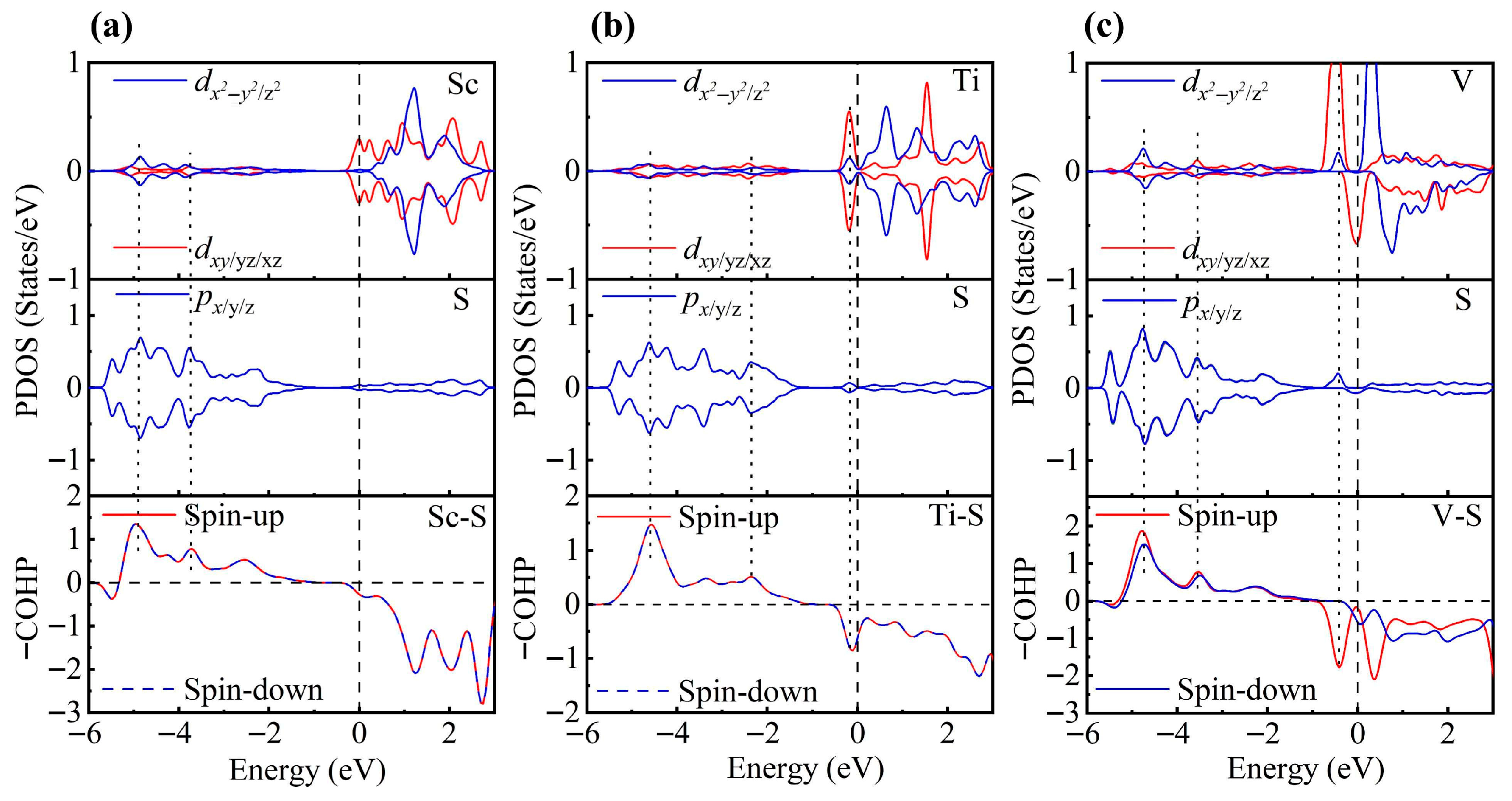
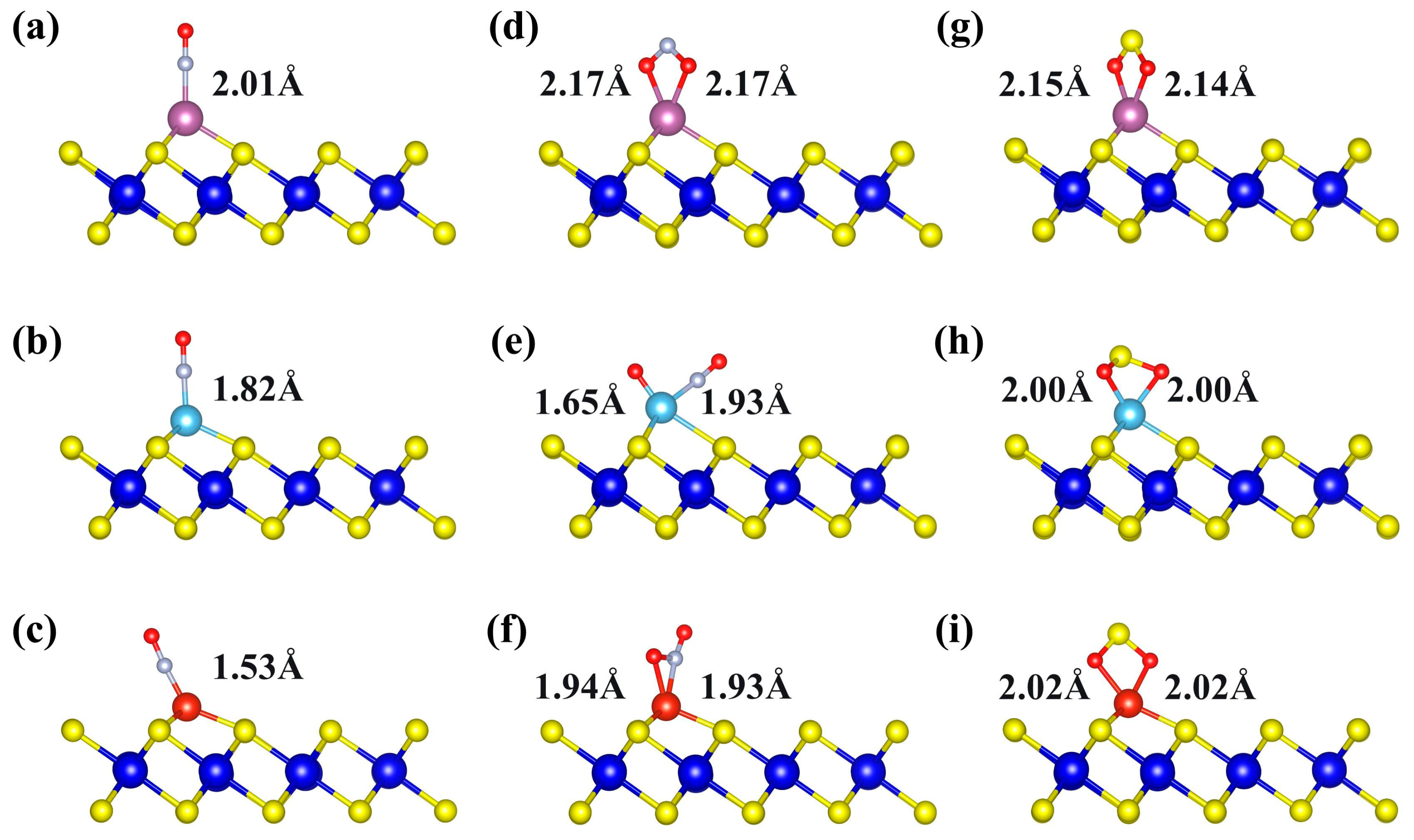
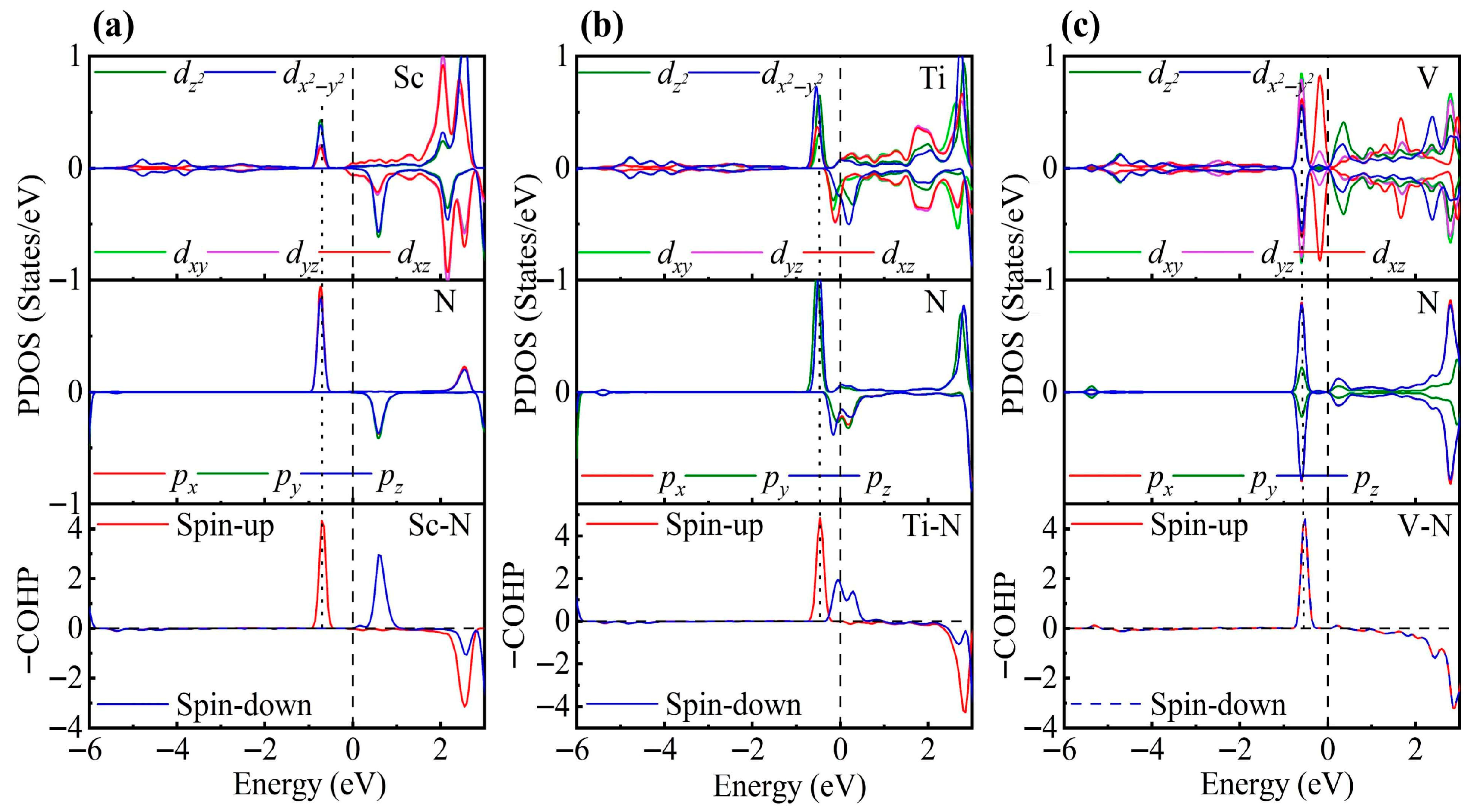

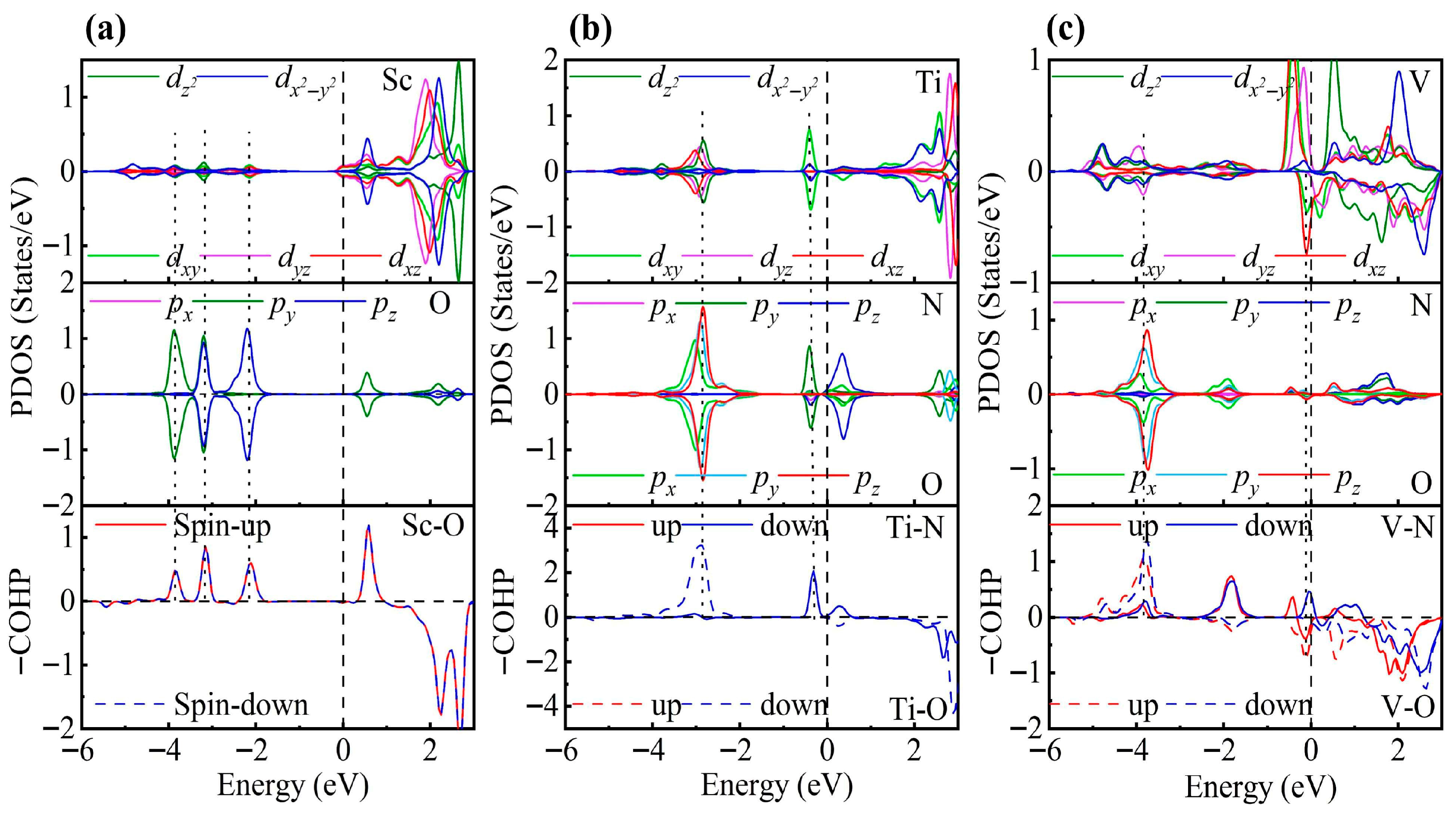




| System | Gas Molecule | Eads (eV) | Qt (e) | Ref. |
|---|---|---|---|---|
| ZrS2 | NO | −0.298 | - | [44] |
| ZrS2 | NO2 | −0.16 | 0.04 | [77] |
| ZrS2 | SO2 | −0.52 | 0.01 | [77] |
| System | Adsorption Position | d (Å) | Ebind (eV) | Qt (e) | ) |
|---|---|---|---|---|---|
| Sc-ZrS2 | TZr | 2.42 | −4.82 | 1.25 | 0.39 |
| hollow | 2.38 | −5.16 | 1.10 | 0 | |
| Ti-ZrS2 | TZr | 2.31 | −4.90 | 0.94 | 0 |
| hollow | 2.29 | −5.35 | 0.81 | 0 | |
| V-ZrS2 | TZr | 2.30 | −3.71 | 0.81 | 2.18 |
| hollow | 2.25 | −4.16 | 0.58 | 0.94 |
| Gas Molecule | Atom | Eads (eV) | Qt (e) | D (Å) | d (Å) | ) | ICOHP (eV) |
|---|---|---|---|---|---|---|---|
| NO | Sc | −2.10 | 0.47 | 2.01 | 1.20 | 1.96 | −2.17 |
| Ti | −2.47 | 0.51 | 1.82 | 1.20 | 0.59 | −3.16 | |
| V | −2.89 | 0.48 | 1.53 | 1.19 | 0 | −3.30 | |
| NO2 | Sc | −3.08 | 0.67 | 2.17 | 1.29 | 0 | −2.32 |
| Ti | −3.63 | 1.08 | 1.65/1.93 | 1.17 | 0.04 | −7.00 | |
| V | −2.70 | 0.56 | 1.93/1.94 | 1.38/1.20 | 1.99 | −2.94 | |
| SO2 | Sc | −2.28 | 0.71 | 2.14/2.15 | 1.55 | 0.97 | −2.54 |
| Ti | −2.21 | 0.73 | 2.00 | 1.61 | 0 | −3.24 | |
| V | −1.63 | 0.63 | 2.02 | 1.56 | 2.96 | −2.61 |
Disclaimer/Publisher’s Note: The statements, opinions and data contained in all publications are solely those of the individual author(s) and contributor(s) and not of MDPI and/or the editor(s). MDPI and/or the editor(s) disclaim responsibility for any injury to people or property resulting from any ideas, methods, instructions or products referred to in the content. |
© 2025 by the authors. Licensee MDPI, Basel, Switzerland. This article is an open access article distributed under the terms and conditions of the Creative Commons Attribution (CC BY) license (https://creativecommons.org/licenses/by/4.0/).
Share and Cite
Wang, X.; Zhang, J.; Zhang, J.; Liu, X.; Lin, Y.; Li, F.; Wang, G.; Xu, Y.; Wang, P. 1T-ZrS2 Monolayer Decorated with Sc, Ti, and V Single Atoms: A Potential Gas Scavenger for NOx and SO2. Nanomaterials 2025, 15, 1653. https://doi.org/10.3390/nano15211653
Wang X, Zhang J, Zhang J, Liu X, Lin Y, Li F, Wang G, Xu Y, Wang P. 1T-ZrS2 Monolayer Decorated with Sc, Ti, and V Single Atoms: A Potential Gas Scavenger for NOx and SO2. Nanomaterials. 2025; 15(21):1653. https://doi.org/10.3390/nano15211653
Chicago/Turabian StyleWang, Xiaoxuan, Jiaqi Zhang, Jinjuan Zhang, Xiaoqing Liu, Yuanqi Lin, Fangfang Li, Guangwei Wang, Yan Xu, and Peng Wang. 2025. "1T-ZrS2 Monolayer Decorated with Sc, Ti, and V Single Atoms: A Potential Gas Scavenger for NOx and SO2" Nanomaterials 15, no. 21: 1653. https://doi.org/10.3390/nano15211653
APA StyleWang, X., Zhang, J., Zhang, J., Liu, X., Lin, Y., Li, F., Wang, G., Xu, Y., & Wang, P. (2025). 1T-ZrS2 Monolayer Decorated with Sc, Ti, and V Single Atoms: A Potential Gas Scavenger for NOx and SO2. Nanomaterials, 15(21), 1653. https://doi.org/10.3390/nano15211653







